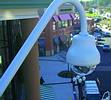

Shoplifting, employee theft, staff and manager improprieties and vandalism – concerns about these and a rash of other issues has led organisations to want and need to see what is happening on their grounds and in their facilities.
The need today, more than ever, is to eliminate problems before they start. Whether concerned with personnel safety or avoiding theft and vandalism, management has learned that guards on patrol are simply not enough. More eyes are needed.
CCTV is providing those eyes for shopping centres and scores of companies big and small. For all, the rule of thumb is the same: One person monitoring a CCTV system sees more than 10 people on foot.
The world has changed; so has CCTV. In the past five years, the price of quality CCTV cameras has dropped dramatically and the capabilities are greatly enhanced. From high on the rooftop of a shopping centre, we now can zoom in and get a clear image of a licence plate way across the car park. A new breed of day/night cameras provides 24/7 monitoring without the need for both a day and a night camera. In addition, lighting requirements are diminished. Such camera breakthroughs make CCTV-based monitoring more affordable than ever.
Outdoors, a typical implementation employs high speed, high resolution, pan-tilt-zoom cameras encased in a weather-resistant dome. Each camera follows a pre-programmed guard tour, moving continuously from one pre-set position to another. Operators can zoom in on objects or areas at will. Outdoor day/night cameras switch automatically between a colour mode for daytime and a more light sensitive monochrome for night time, providing 24-hour coverage in all light conditions. These two-in-one cameras, as previously mentioned, not only cut the number of cameras needed, but also divide the number of domes needed for the system in half. They also reduce the costs of other hardware and installation labour as well as future maintenance expenditures. By being able to produce clear images in low light, organisations save the expense of installing additional lighting.
If a facility is plagued by vandalism, the domes can be made of Lexan polycarbonate, similar to that used on hockey mask face shields. Heavy-duty housings can be built of 0,187 aluminium to add increased toughness. Indoors, most buildings mix pan-tilt-zoom cameras along with fixed position cameras. It is suggested they be encased in the domes to avoid being vandalised. Where 360° of viewing are preferred, such as the central junction of four corridors, the pan-tilt-zooms are placed. Individual hallways use the fixed position cameras, which cost less.
Companies are digital, compact combination digital video multiplexers/recorders (DVMRs) operate similarly to traditional multiplexers and VCRs but display live video and record high-resolution pictures on a hard drive. Either locally or at a central monitoring station, these DVMRs provide instant access to critical recordings by using on-screen menus and simple keystrokes to find images or events by alarm, time, date or camera number.
Digital also provides additional, not so obvious benefits. When hooked into the company's computer network, recordings and monitoring can be made available to authorised personnel anywhere in the organisation via their PCs. Since most managers are computer-literate, especially with Windows, easy access to more people puts more eyes on the system. If there is a crisis, management want to see it now. With such a digital system, managers can indicate what to record and, since the images are on the network, they can be pulled up on a PC from anywhere in the district. Additionally, image archives can be taken from any camera at any time to aid in security and liability factors as well as training.
Although CCTV systems can provide years of storage, that should not be the objective. As with computers (which these systems really are), added storage can mean added expense. Therefore, although companies are not as constrained with digital as they are with tape, this should not be a licence to record everything at full speed. It is suggested that the system should be operated at faster speeds (higher frames per second) at times and locations when and where the company experiences the most problems. Elsewhere, the system runs at lower speeds.
For instance, during business operations, all systems might be running at a faster rate but, after closing, they run at a slower rate. The digital user has much flexibility. For instance, users can select a different record rate for each camera as well as set each camera to record in time-lapse mode, event mode or both.
As an example, one camera could record one picture per second continuously (time lapse). A second camera could be set to record nothing at all until an event happens, such as a door opening, at which time it would record up to 30 pictures per second (event). A third camera could record at three pictures per second until an event occurs, at which time it could begin recording at a higher rate (time lapse and event). Thus, users can capture what they want, when they want it, without recording unwanted information.
The paradigm has changed
With the massive changes technology has brought to CCTV over the last half decade, organisations are now putting more eyes on their facilities and grounds than dreamed possible only five years ago. Such improvements are not the bastion of any one supplier or integrator. The cost of cameras and equipment are lower, across the board.
To get started, it is highly recommended that one talks to other companies and organisations in one's area, which have successfully implemented a CCTV program. Then, talk to the professionals who helped them create a system that will work for you.
About the author: Darren Nicholson is director of marketing for GE Interlogix' Kalatel CCTV division. GE Interlogix is a global company and has operations in over 30 countries and is represented by some of the well-known brand names in the industry, including Aritech, Caddx, Fiber Options, GBC and Kalatel.
© Technews Publishing (Pty) Ltd. | All Rights Reserved.